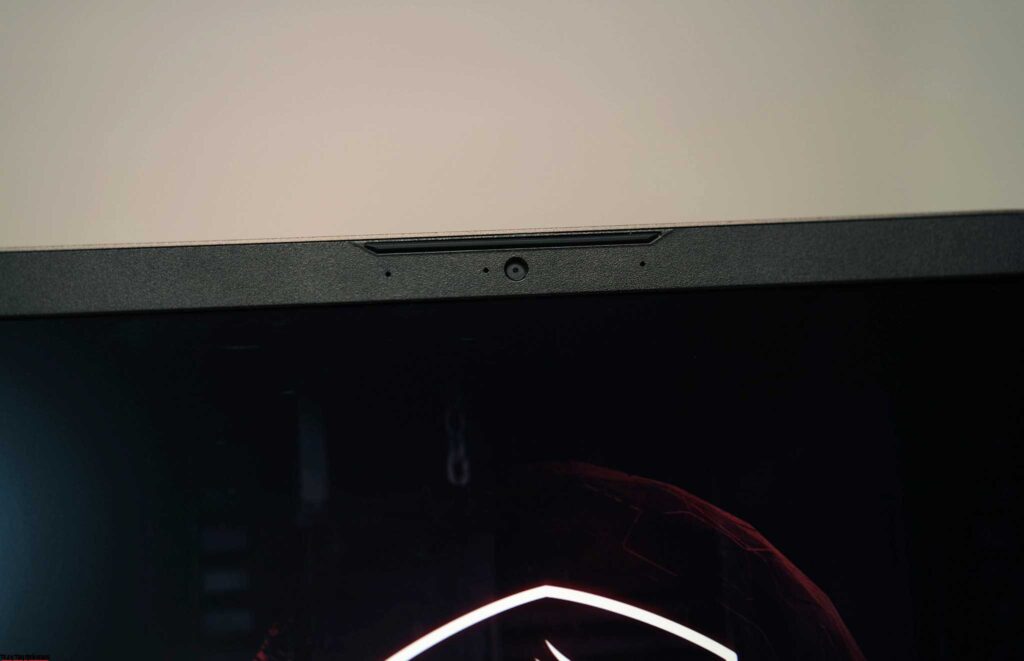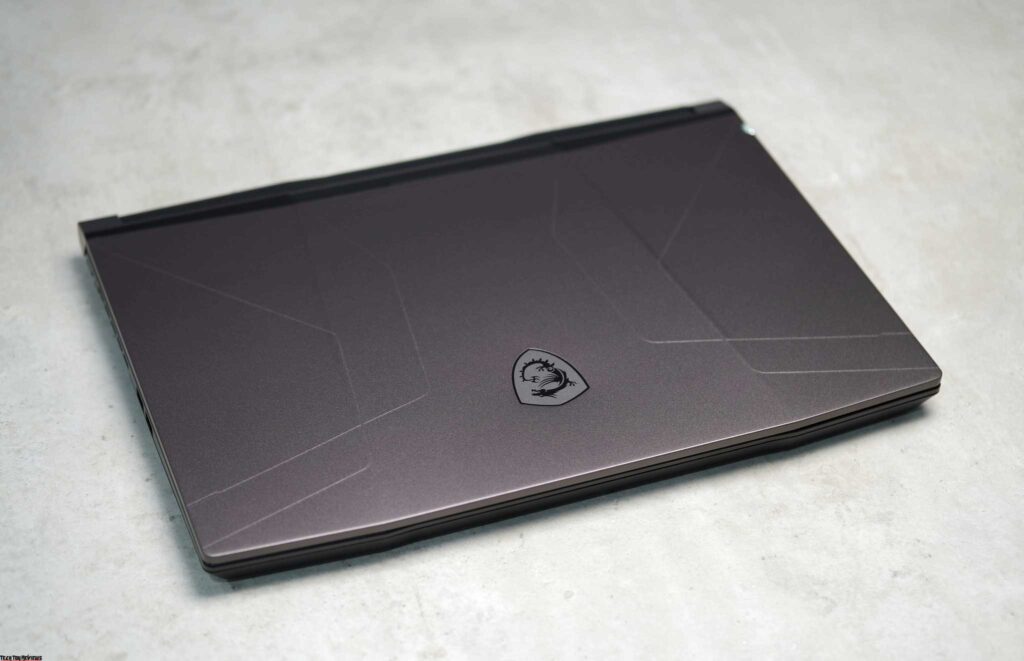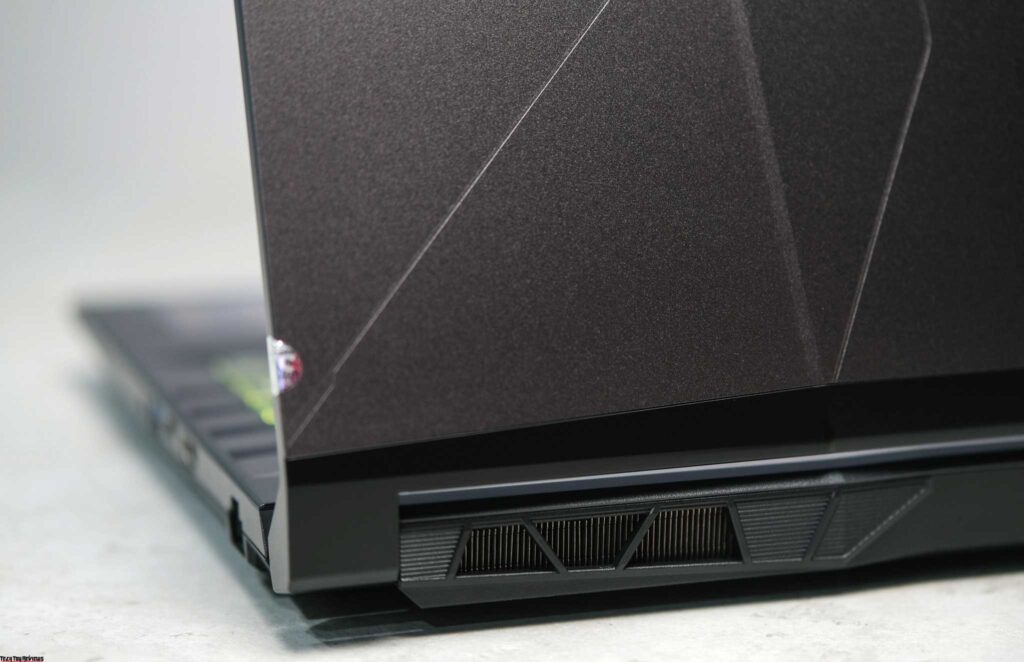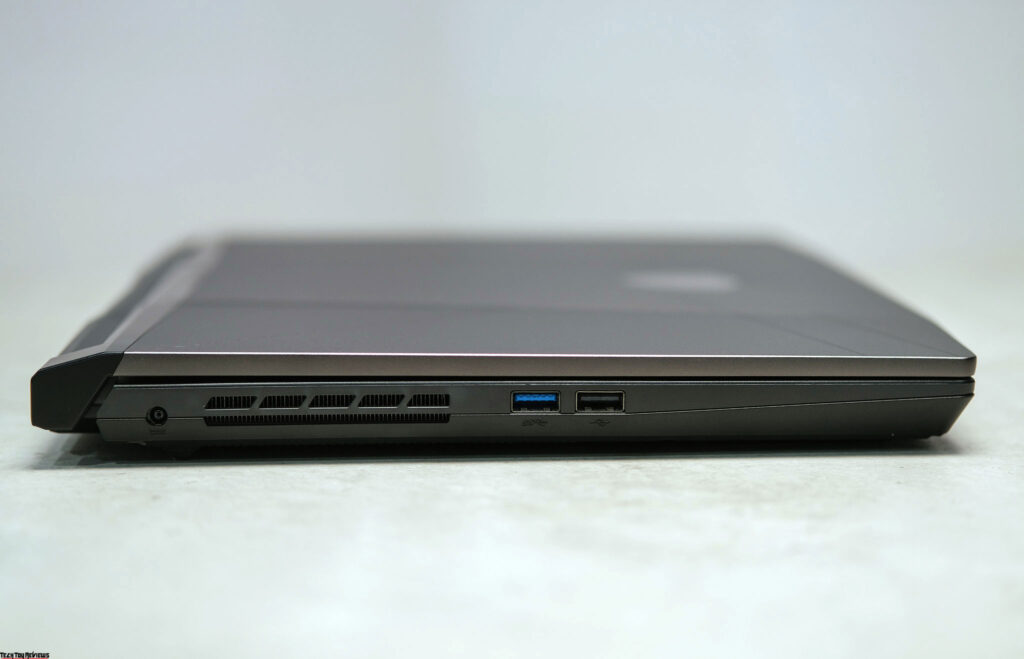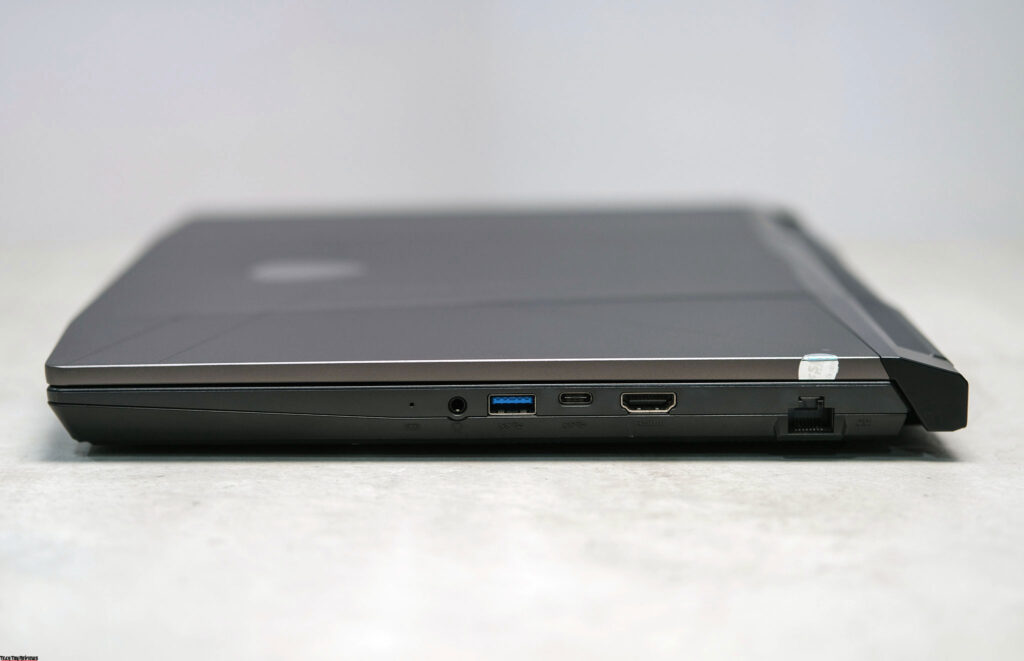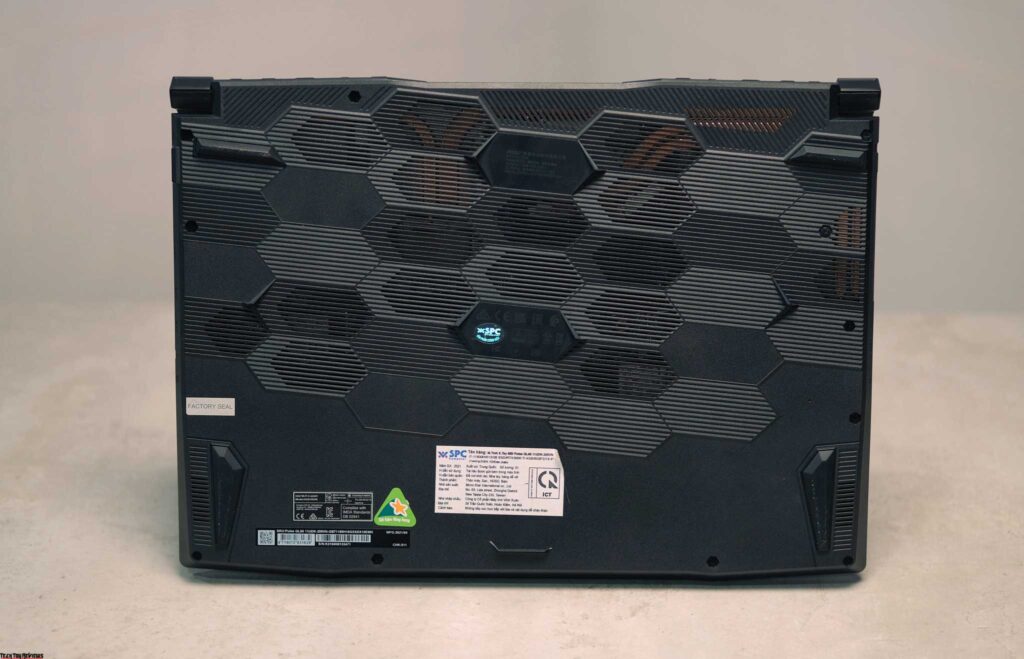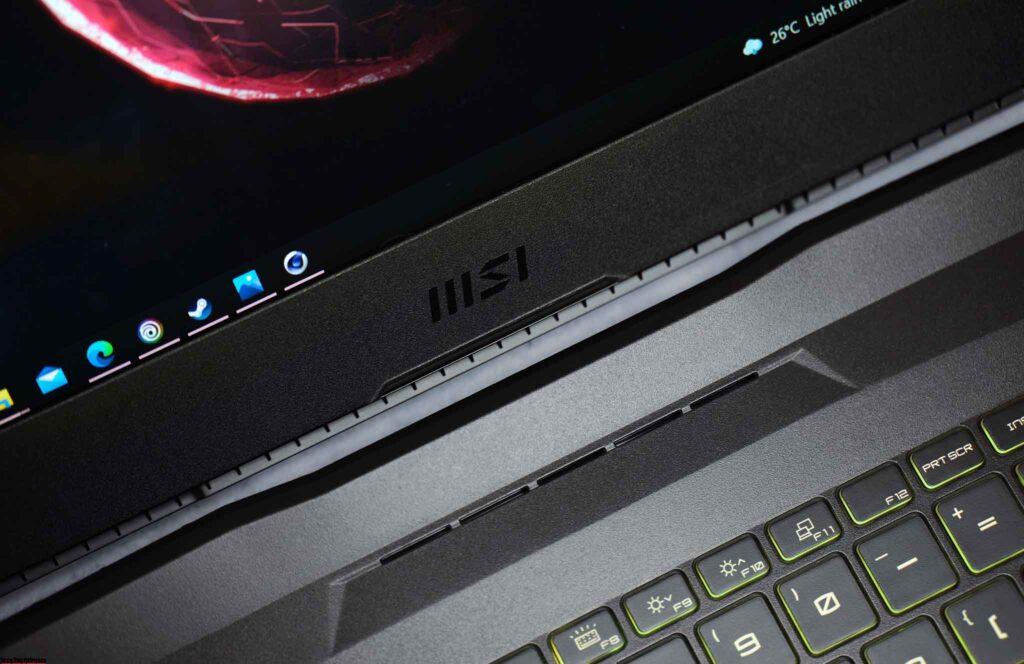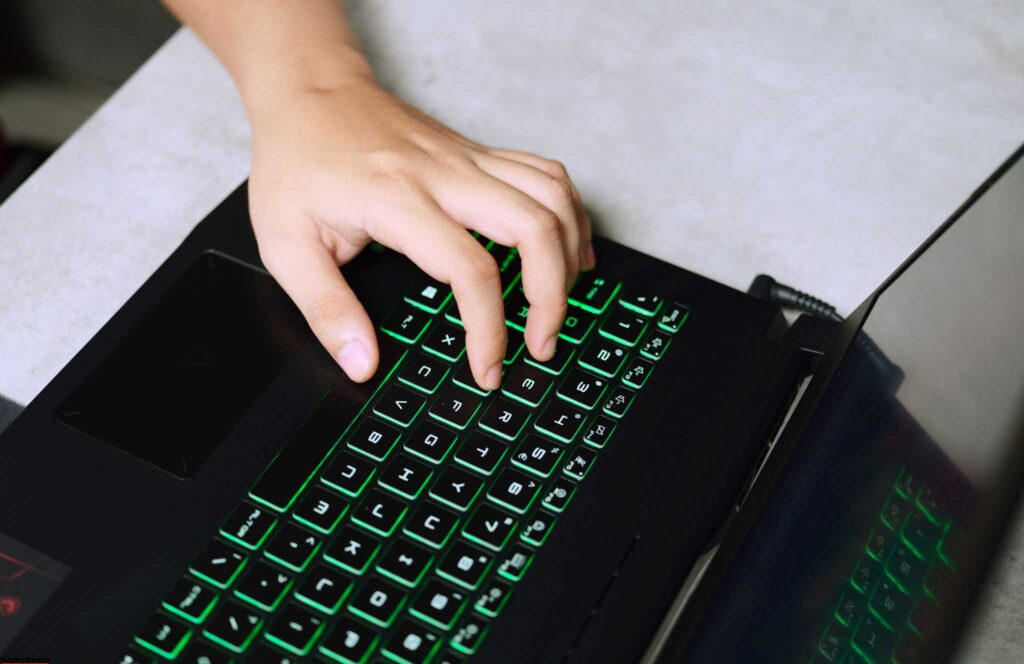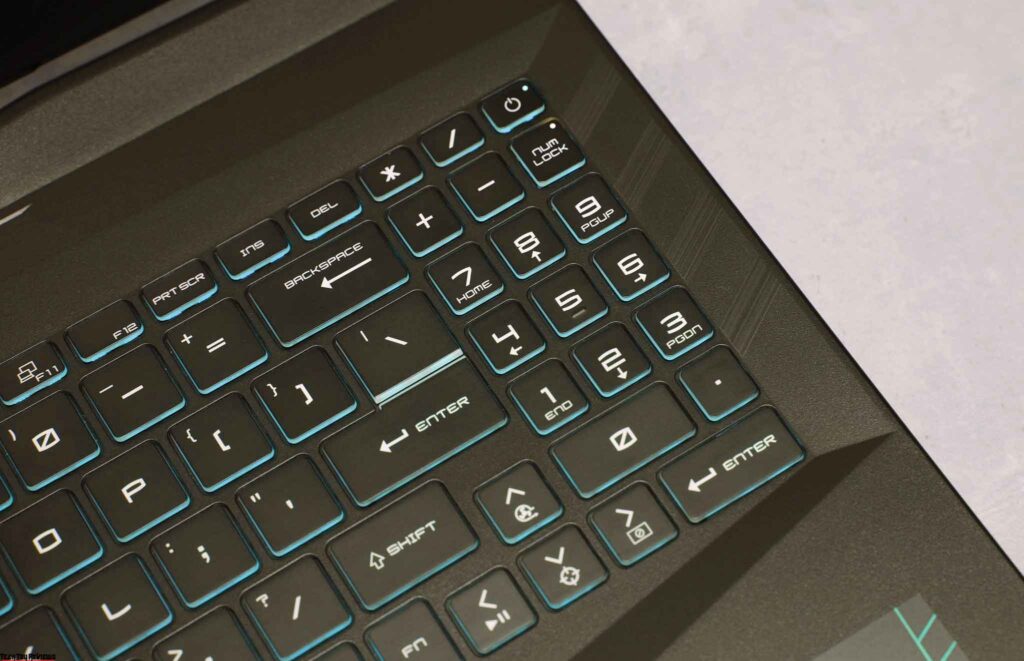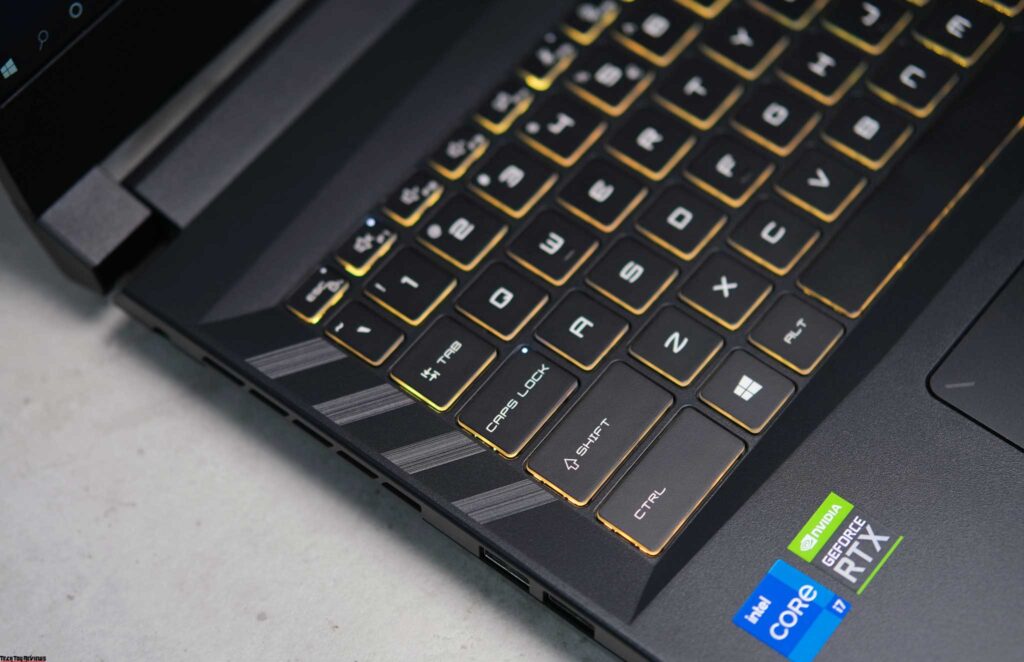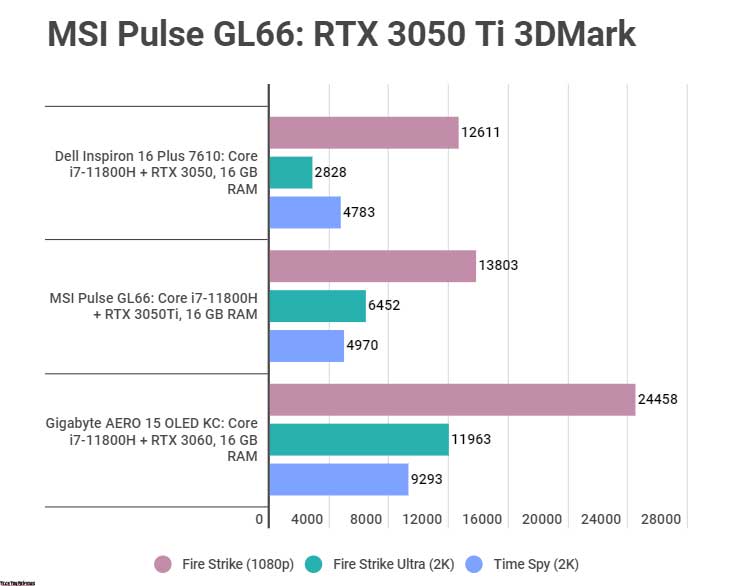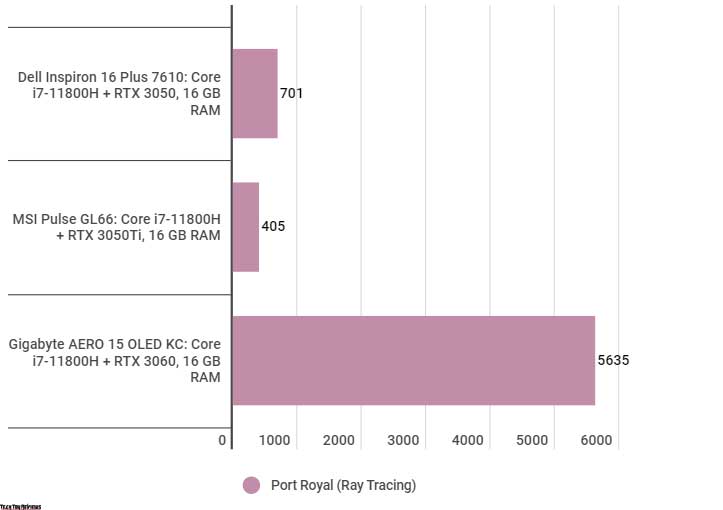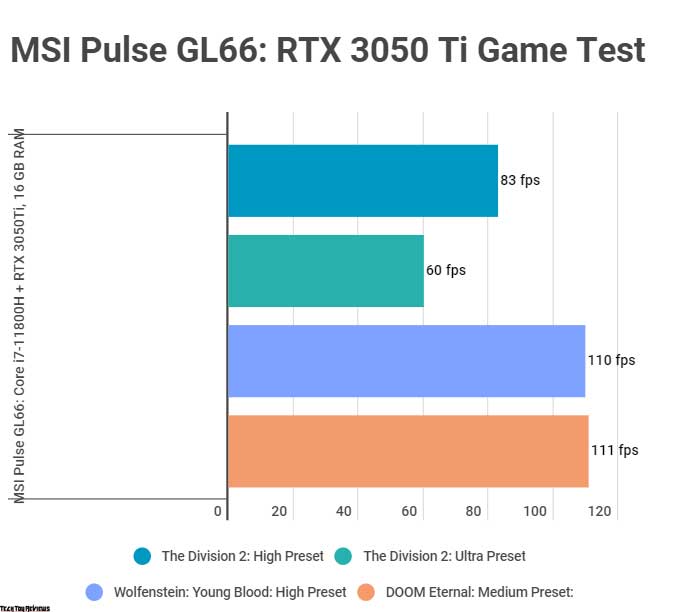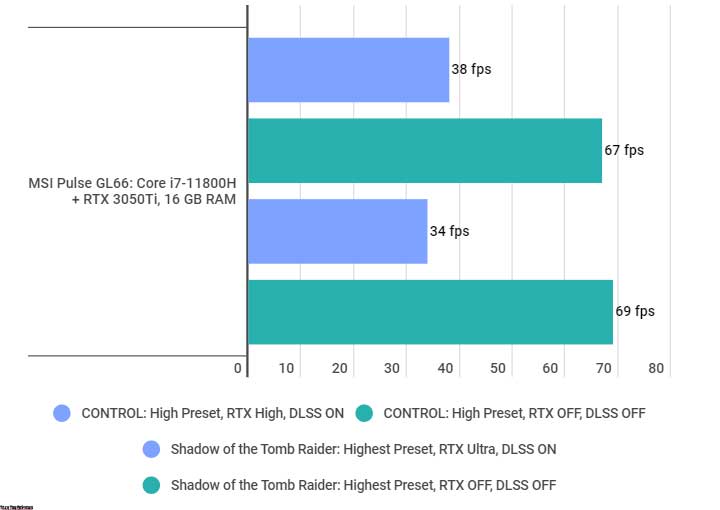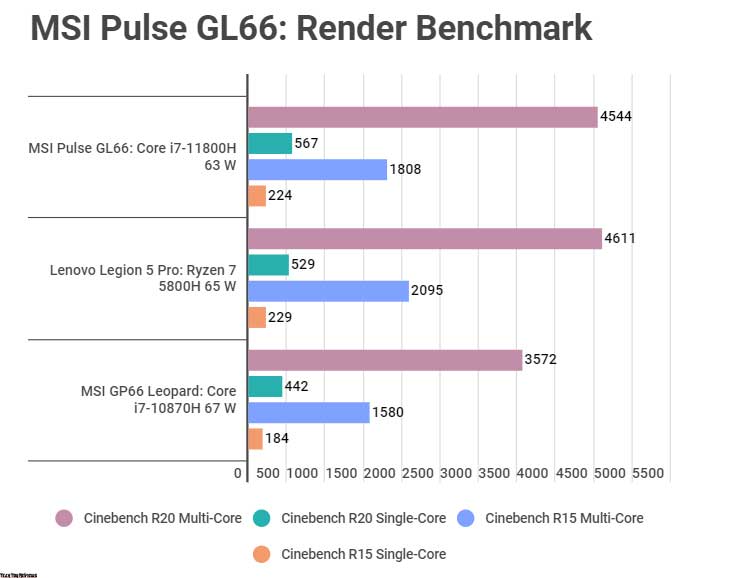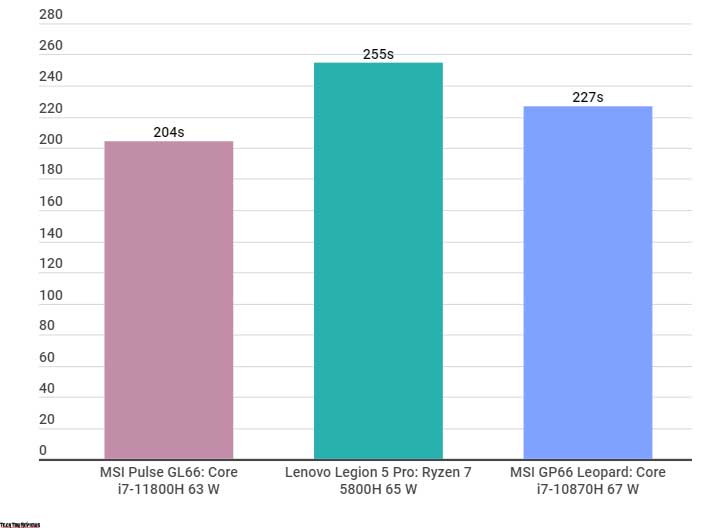The Pulse GL66 is a new line of MSI laptops aimed at gamers in the price segment of $1500-2000. We have been using it for the past few days, sharing what we saw here in this MSI Pulse GL66 review. So that you can choose or buy and then use it more effectively.
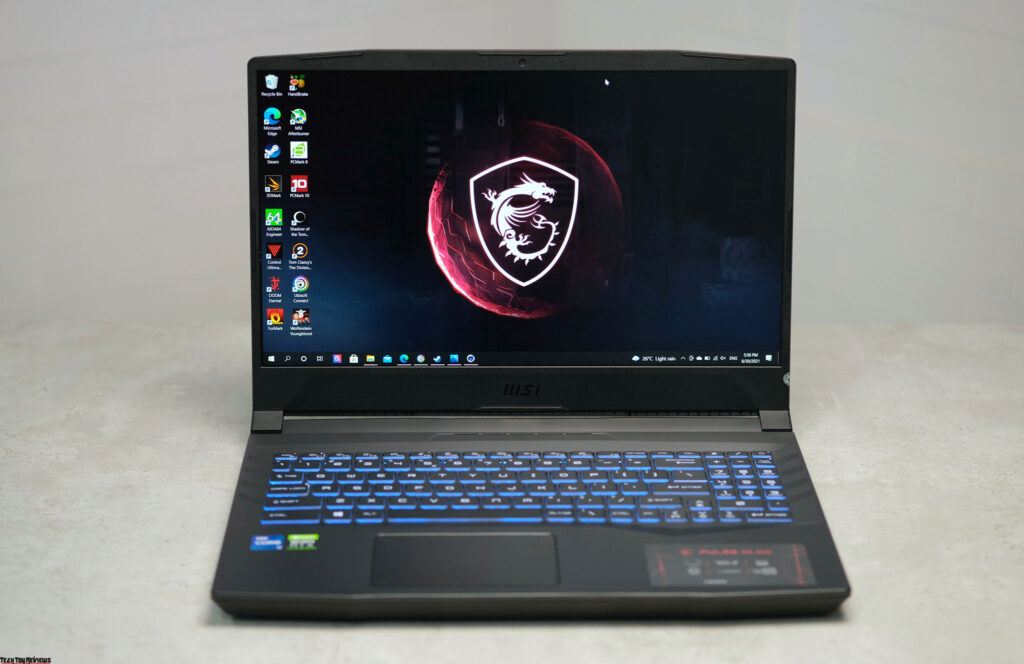
Design
The Pulse GL66 owns a new design, very different from MSI’s older laptops, with an A-side made of gunmetal-gray aluminum, smooth surface treatments, engraved symmetrical lines. This barrel gray and texture was designed by a Belgian 3D artist, and it matches a 3D character that was custom-built by MSI for this Pulse series. The MSI logo is engraved but without any lights.
At the back, there are still 2 familiar heatsinks on either side, the space in the middle is still empty, but we think MSI should put the lower connection port on the back, especially the power port, screen output, LAN to use conveniently. The latter’s edge design is no longer as prominent as that of previous-generation MSI laptops, making the Pulse GL66 look quite supple that, if you compare it to the GL75 Leopard, you’ll notice a noticeable difference. The weight of this gaming laptop is about 2.25 kg, it is not too heavy for us and can be carried daily.
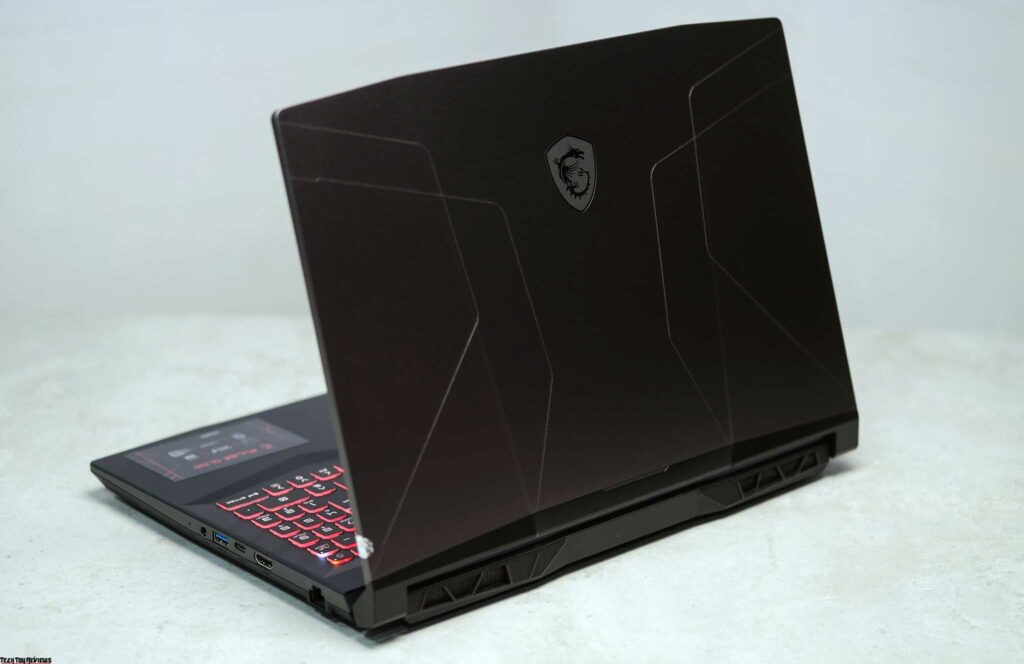
The system of ports on the Pulse GL66 is sufficient for the needs of a typical user or gamer but will be lacking for those with higher needs, usually those who want to use this machine for related work or movies.
On the left edge, the laptop has another heatsink slot, which is connected to a pin power port, a USB 3.2 Gen1 port (USB 3.0, 5 Gbps), and a USB 2.0 port. USB 2.0 ports are almost gone on laptops now, but some companies still use them, especially on cheap gaming laptops. It’s on the left, so we think MSI made this design specifically for the mouse, just a USB 2.0 connection is enough, but adding a USB 3.0 port is still better, and we don’t think it costs much.
On the right is an HDMI 2.0 port that supports 4K@60Hz output, 2 USB 3.2 Gen1 ports (USB 3.0, 5 Gbps), including 1 USB-C port, 1 USB-A port, RJ-45, 3.5mm jack, and pinhole are included. The laptop doesn’t have an SD card reader and doesn’t support USB-C export, so export options are pretty limited, just enough for a casual gamer’s needs.
The Pulse GL66’s bottom is quite open, with MSI still designing the bottom cover as a solid plastic tray that can be easily removed for hardware upgrades or maintenance. The bottom is cut in a honeycomb pattern with several holes, the rubber feet on the bottom being thick and tough, slightly lifting the bottom of the machine to get air. Looking at the slots, you can see the Cooler Boost 5 cooling system with 4 copper pipes. However, the number of copper pipes will vary by configuration.
Display
The screen size of the MSI Pulse GL66 is 15.6-inch, 16:9 aspect ratio, 1920 x 1080 pixels resolution with a refresh rate of 144 Hz. The screen design on either side is about 7 mm thin, and the top 1cm border contains the cluster. 720p @ 30fps webcam camera quality is acceptable and good enough for meetings and online learning.
Testing the panel in this MSI Pulse GL66 review, this device uses a B156HAN08.0 panel from AUO Optronics. This panel uses AHVA technology – a variant of IPS developed by AUO, similar to Samsung with PLS and LG with AH-IPS. AHVA stands for Advanced Hyper-viewing Angle, it is not the same as VA (Vertical Alignment), so you should avoid confusion here. AHVA’s operating mechanism is still based on IPS, it has the advantage of being faster than traditional IPS panels, but colors will be poor. That’s why MSI often uses the term “IPS-like” in the devices’ screen description.
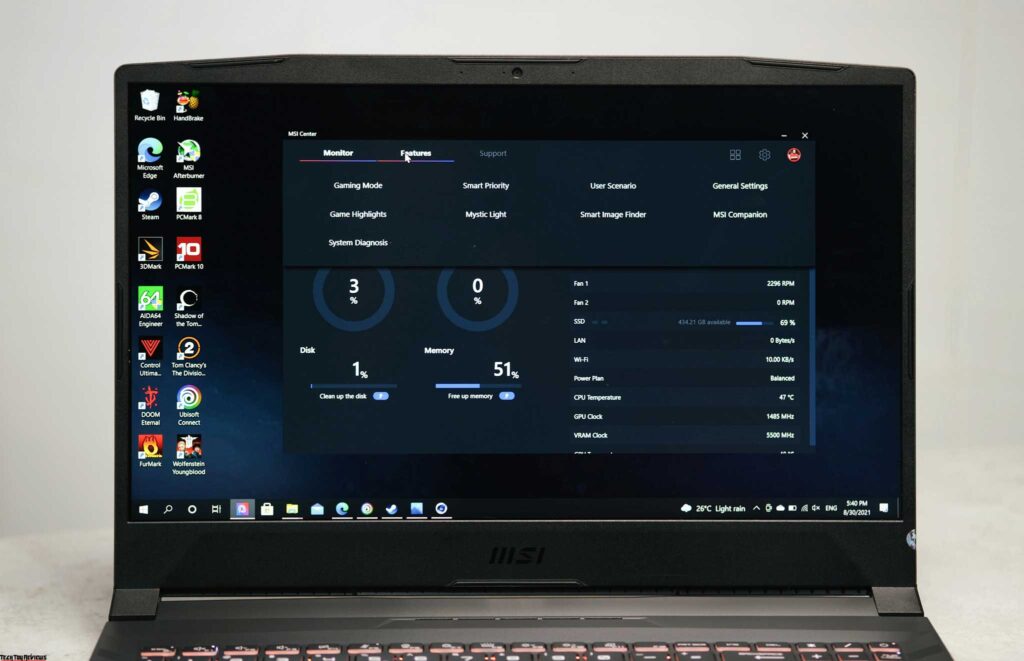
The B156HAN08.0 panel is commonly used on gaming laptops from MSI and competitors like Asus, and Acer. It has a fairly good color gamut coverage with 72% NTSC band, 92% sRGB range, 65% AdobeRGB range, its contrast is close to 1000 so it is highly suitable for entertainment needs with games and movies. It must also be mentioned that the 144Hz refresh rate is now standard on gaming laptops.
Screen brightness is around 260 cd/m2, wide viewing angle as it is still basically IPS, so it is not limited in terms of viewing angle. The matte screen type is quick, with this brightness, you can comfortably sit outside or in the park to work. We are very satisfied with this screen selection, our MSI Pulse GL66 review unit comes with RTX 3050 Ti configuration, 144Hz is more than enough to provide a smooth gaming experience.
Audio
Near the front edge of the device, there are two speakers mounted on the bottom, the sound is directed down and the echo is up. Each speaker has a capacity of 2 W, the output volume is large, and we often install Dolby Access software to enhance the speaker’s sound effects. When playing a shooting game, the sound we find is quite exciting, using the external speaker solely to play the game and not just an “anti-deaf” solution.
Keyboard and touchpad
The Pulse GL66’s keyboard is full-sized, the company reverts the number pad system to a 15.6″ laptop, the size of the number key system is small, narrow but still easy to press and doesn’t affect the key layout much. This numeric key cluster is narrower, so the positioning of the keys is no longer standard on a regular full-size keyboard, but rather like a keyboard on a handheld computer, with separate keys for addition, subtraction, multiplication, and division. Enter key at the bottom. For us, this layout is also easy to use and can be quickly manipulated once you get used to it.
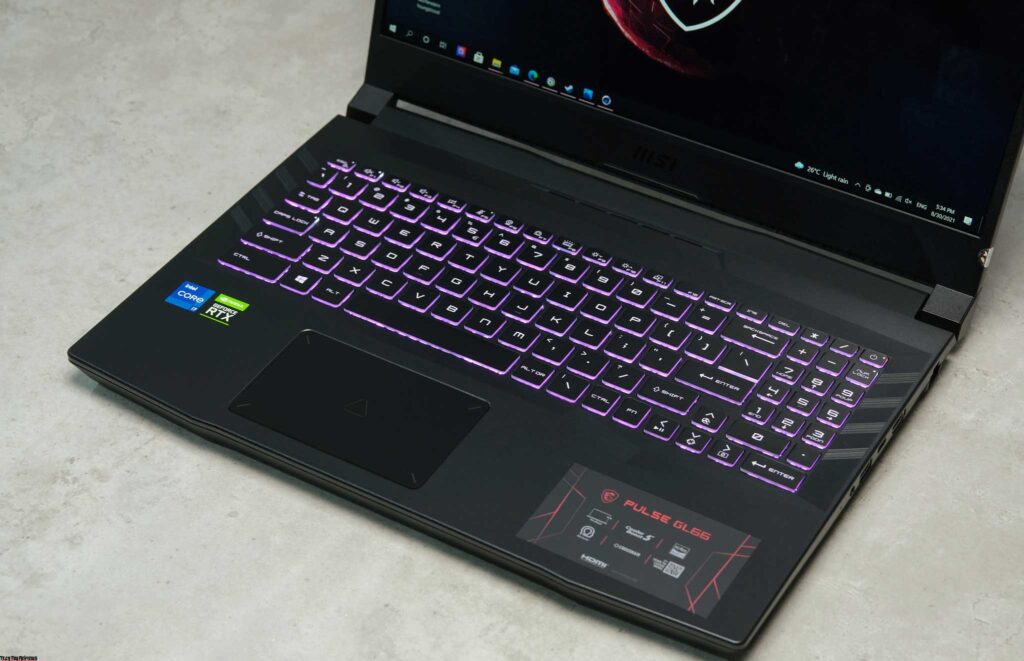
The main key layout is still in the familiar style of the MSI, although it is slightly to the left, there is still room for the left palm to rest comfortably on the mat. The main key still has a standard size of 15 x 15 mm, the keycap stands out with the keycap edge made in MSI’s silver lining style, it’s transparent from which the RGB light shines beautifully. The characters on the keycap are clear and bright.
However, compared to the MSI laptops we’ve used before, this layout has some differences, and we’ll have to get used to it. For example, the left Control key is enlarged to be equal to the Shift key – the purpose is to optimize the game because Control is also the key used for sitting operations of most FPS and TPS games. The Fn key is moved next to the right Control key, so pressing the Fn + other key combination will require 2 hands.
The top row of Function keys has several extra function keys used with Fn which are very useful such as Fn + F6 to turn off the webcam, Fn + F5 to turn off the mic, Fn + F4 to turn off the trackpad, quickly switching between performance modes in MSI Center with Fn + F7, Fn + F8 light effect. In addition, you can manually activate Cooler Boost to push the fan speed to the maximum with Fn + up key or turn on a virtual heart with Fn + down key. It can be seen that the keyboard is fully equipped with MSI gaming utilities.
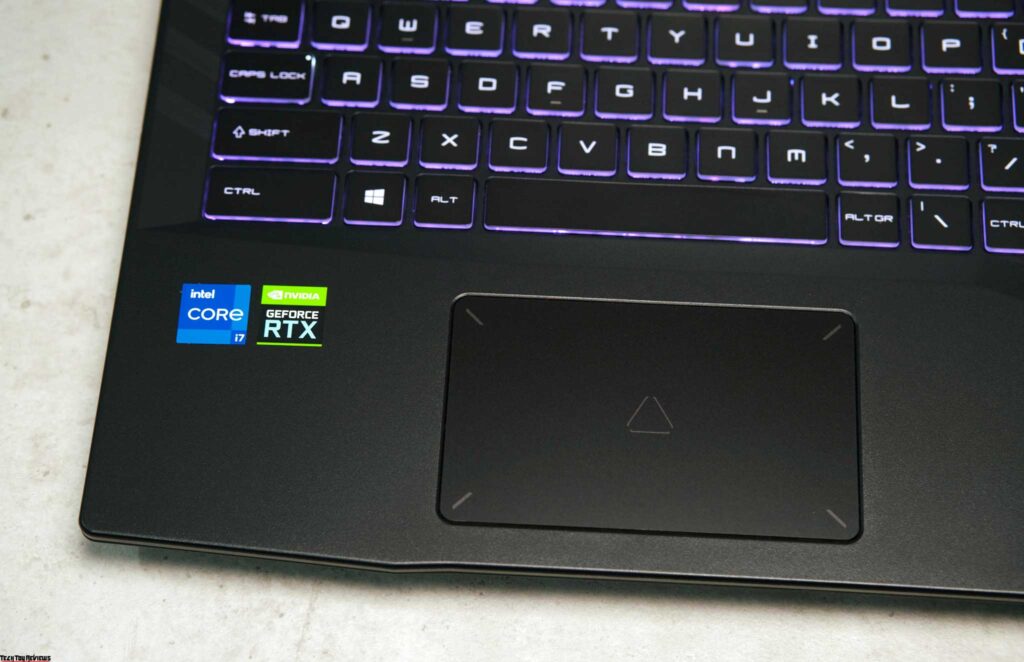
The keyboard supports RGB backlighting, but unfortunately, all-key lighting instead of each area or each key. The light effects can be adjusted in Mystic Light, but there are only some basic effects such as Breathing, Color Shift, no color changing Wave effect like GL65 Leopard.
Regarding the feeling of typing, we’re only temporarily satisfied with the Pulse GL66’s keyboard because although the keys have a deep travel, there are 2 points we don’t like that the keycap surface is quite smooth and the bounce of the key is not enough, it slightly soft. The Flex keypad is lightweight as the device’s internal structure is entirely plastic, so when typing quickly or working fast, we felt less confident on the Pulse GL 66’s keyboard.
The touchpad on the device has a new design, size 10.5 x 6.5cm, not too big. It’s in the form of a click pad with integrated mouse keys under the trackpad, the surface is smooth, with good multi-point support, sensitivity, and a pretty texture. Although the bottom two mouse buttons are a bit stiff, for us the power to press the mouse button on this trackpad is acceptable, but for many brothers, we think it’ll be a bit tiring.
MSI Pulse GL66 Specifications
We have seen 2 configurations of the GL66 series sold online, the main difference is in the GPU. Our MSI Pulse GL66 review unit has the following configuration:
- CPU: Intel Core i7-11800H (Tiger Lake-H45), 8 cores 16 threads, 2.3 – 4.6 GHz (Turbo Boost), TDP 45 – 65 W;
- iGPU: Intel UHD Graphics Xe 750 32 EU (Gen12);
- GPU: NVIDIA GeForce RTX 3060 Ti (Ampere GA107), 2560 CUDA cores, 80 Tensor cores, 20 Ray Tracing cores, 1485 MHz Boost, 4 GB GDDR6 128-bit, TGP 60 W;
- RAM: 2 x 8 GB Kingston DDR4-3200 CL22-22-22-52;
- SSD: 500 GB Kingston NV1 PCIe 3.0 x4 NVMe;
- Connectivity: Bluet0oth 5.2 + Wi-Fi 6 802.11ax;
- Battery: 52 Wh;
- OS: Windows 10 Home
Performance
The Core i7-11800H is a very popular processor on gaming laptops and current laptop manufacturers. It belongs to the Tiger Lake-H45 series, has 8 new Willow Cove architecture cores, uses the new 10nm SuperFIN process, so it brings a significant improvement in IPC as well as better performance/power compared to the Comet Lake generation- H. With 8 cores and 16 threads, its performance will be slightly better than the Core i7-10875H and on par with the Ryzen 7 5800H. In the Tiger Lake-H generation, Intel has supported new technologies such as PCIe 4.0, memory microcontrollers that support RAM speed of 3200 MHz.
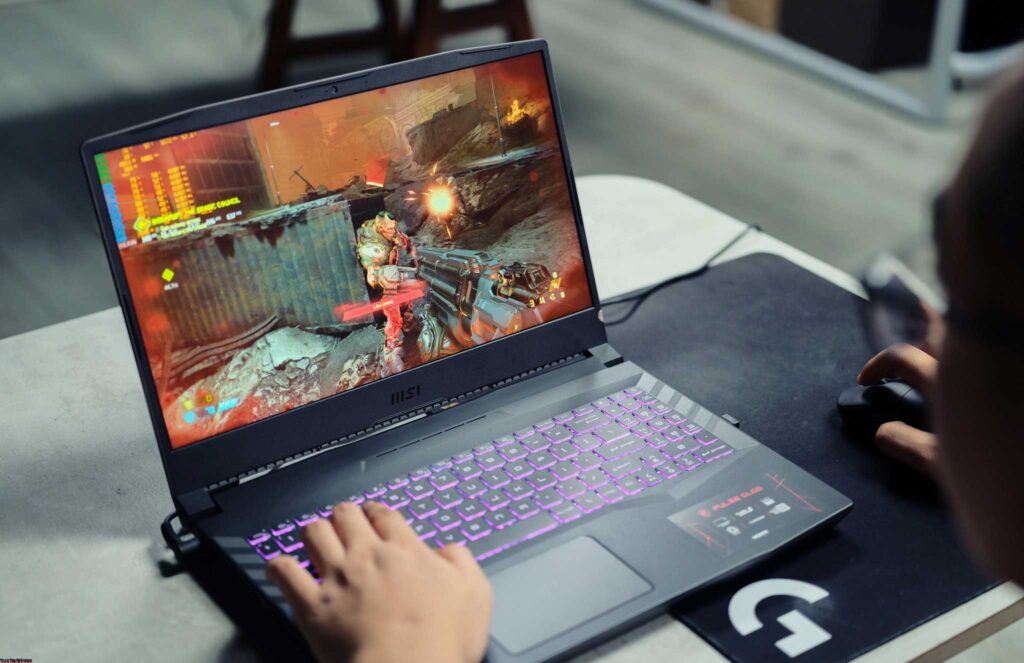
On the GL66, it comes with the HM570 chipset, which we think will support more high-speed connection ports like USB 3.2 Gen2 (10 Gbps) or even Gen2 x2 (20 Gbps), Thunderbolt 4, and PCIe 4.0 x4 drive. However, MSI still decided to reduce costs, so the GL66 lacks the high-speed connections required on a high-end mid-range machine.
The RTX 3050 Ti is another story, it is the GPU on the laptop that makes us very curious about the performance as it uses a completely different GPU than the RTX 3060. The GA107 is the GPU that first appeared on the line of specialized graphics cards. The A16 industry then was used on laptops for the RTX 3050/3050 Ti series, with a version of the RTX 3050 Ti containing 2560 CUDA cores, 80 Tensor cores, and 20 Ray Tracing cores. In terms of parameters, the RTX 3050 Ti is quite impressive, but its limitation is that it supports only 4 GB of GDDR6 memory, connected by a 128-bit wide bus with a bandwidth of 192 GB/s. With current AAA games, 4 GB of VRAM will not be enough for you to experience high-level graphics configuration with full Ray Tracing effects.
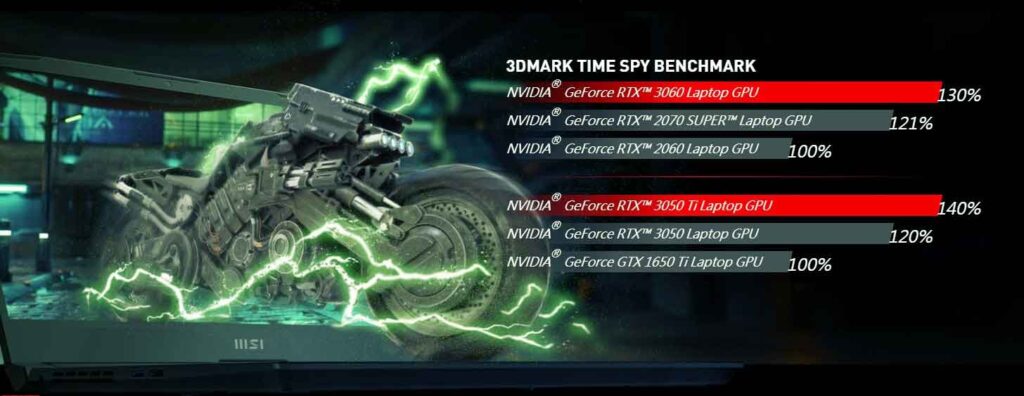
When checking the gaming performance of the RTX 3050 Ti on the Pulse GL66, we found it pretty clear. First, with 3DMark, we compared the RTX 3050 Ti with the RTX 3060 on the AERO 15 OLED XC (REVIEW) and the RTX 3050 on the Dell Inspiron 16 Plus 7610. The results show that:
The RTX 3050 Ti achieved 13803 graphics points with the Fire Strike test that simulates DirectX 11 games at 1080p resolution, losing up to 10600 points compared to the RTX 3060 Mobile and only slightly better by nearly 1200 points compared to the non-Ti RTX 3050. Similar to Time Spy, which emulates DirectX 12 games, the performance difference between the RTX 3060 and RTX 3050 Ti exceeds 4,300 points. But switching to the Ray Tracing test to exploit NVIDIA’s RT core, the Pulse GL66 was unsatisfactory, it only scored 405 points, on the other Inspiron 16 Plus we saw a result of 701 points, there is a deviation somewhere but overall it is ok. Not strong enough to perform this test with high performance. As soon as we opened Port Royal, the 3DMark software warned that the machine configuration was not eligible, what was missing here was VRAM memory.
Experiencing a few games, both games that don’t support Ray Tracing and games that do, we noticed: If you only need to play games at 1080p resolution without Ray Tracing, set graphics to medium to high, then RTX 3050 Ti on Pulse GL66 can respond well. In this MSI Pulse GL66, we’ve tested 2 games that support ray tracing and DLSS, including Control and Shadow of the Tomb Raider, the results for turning ray tracing on and not turning on ray tracing are very different. The RTX 3050 Ti is still a mid-range GPU after all, and it won’t be able to let you play games with max settings.
As for the Core i7-11800H, we’ve tested it on at least 3 recent laptops, the Core i7-11800H’s performance on the Pulse GL66 is pretty good, it’s basically limited to PL2 at 65 W, while some models have better cooling systems allowing it to run up to 93 or 109 W. We share a bit about using the Core i7-11800H on the Pulse GL66 for rendering or running multi-core tasks.
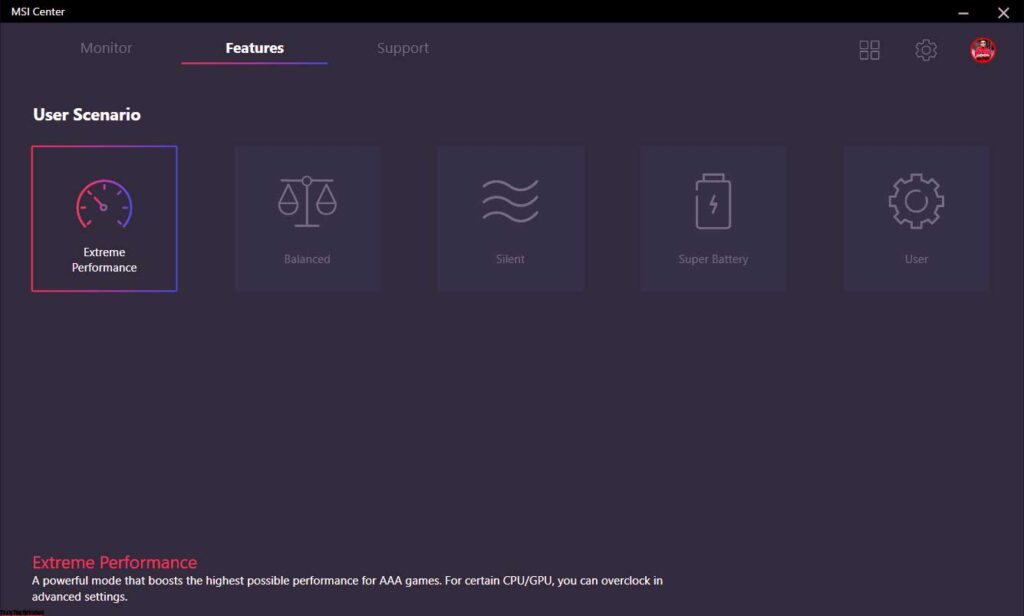
The software has 4 performance modes including Extreme Performance, Balanced, Silent, and Super Battery. When running multi-core tasks, you should give up on Extreme Performance as the CPU will be able to run up to 65 W, we usually see around 63 W when running a Cinebench R15 or R20. If left in Balanced, this mode balances system performance and heat dissipation, so it only allows the CPU to run at a maximum of 45W.
As a result, when we tested Cinebench R20, at Extreme Performance, Core i7-11800H reached 4500 multi-core points while Balanced made the performance score only 3179 points. The single-core score remains unchanged between the 2 modes. The Core i7-11800H’s multi-core clock typically reaches 3.5 – 3.6 GHz in Extreme Performance mode and Balanced is only about 2.3 – 2.5 GHz.
This is the benchmark result between the Core i7-10870H running at 63 W with the Core i7-11800H on the GP66 Leopard that we tested and the Legion 5 Pro running the max 65 W Ryzen 7 5800H. It can be seen that Core i7-11800H is on par with Ryzen 7 5800H with multi-core, single-core wins, and Comet Lake-H generation is well ahead of Core i7-10870H.
Choose Extreme Performance and run the render, the Core i7-11800H core temperature is kept at 89 °C, with 2 or 3 cores reaching 95 °C. If using Balanced mode, the CPU temperature is only at 80 °C as it limits TDP to 45 W, the Cooler Boost 5 cooling system on the Pulse GL66 has substantial cooling performance.
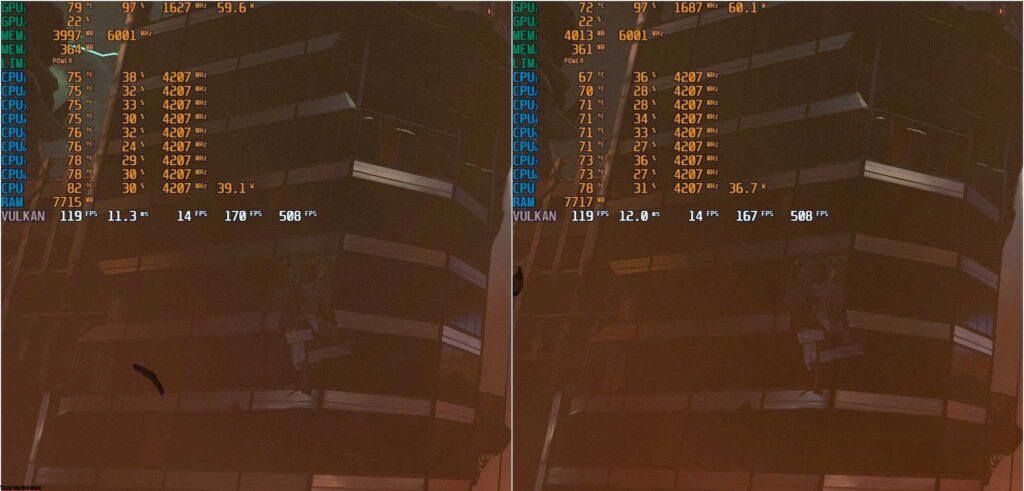
The CPU and GPU temperature will remain cool while playing the game. For example, our gameplay test on MSI Pulse GL66 review unit is DOOM Eternal, playing in the same game scene in the medium configuration. On the left is the Extreme Performance mode, 2 fans spin at 4000 rpm average, GPU temperature is around 79°C, Custom CPU will range from 75 to 82°C. On the right when Cooler Boost is activated, 2 fans spin at 6000 RPM, loud noise but fairly low-temperature compensation, GPU down 72°C, custom CPU 67 to 78°C down.
Battery life
With regards to the battery, the Pulse GL66 is equipped with a true-capacity 52 Wh battery that we tested via AIDA64, which MSI lists as 53.5 Wh. This capacity is not huge, enough to work for a couple of hours. We tried working with 75% screen brightness, Balanced battery mode, basic tasks like web surfing, and editing, after 2 hours 15 minutes, the battery from full to 15%. If you want longer battery life, you can switch to Super Battery mode, then the CPU’s clock will drop below 2 GHz, it only eats up to 10 W, still enough to handle basic tasks quickly, while saving more battery.
Final line
Overall, we think the MSI Pulse GL66 is a good laptop, it appeared in a period of high chip prices, very good performance, good design. MSI has tried to cut a few things like ports, single-color RGB keyboards to keep prices competitive. However, the Pulse GL66 will face many formidable competitors in this segment, both in terms of design and configuration.
The selling price of our MSI Pulse GL66 review unit is $1,299 and goes up to $2,399.99, and it can be purchased via the Newegg.com, Amazon.com, and Amazon.co.uk online stores. At this price, we think the Pulse GL66 will be able to compete better.
And yes, how did you like this MSI Pulse GL66 review, do tell in the comment section below.
